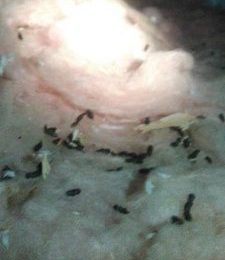In this week’s blog post we’re getting transparent about temperature regulatory processes in clear wing butterflies! Violine Ossola and team explore the sensitivities around thermal regulation in the neotropical tribe of butterflies known as Ithomiini. In their paper, “It’s cool to be clear: transparency induces a thermal cost in clearwing butterflies”, they describe how clearwing and opaque butterflies tackle temperature gradients via different behavioural and physiological adaptations in the Andes of Ecuador and Peru. Through their research, Ossola and team teach us a valuable lesson: Don’t be surprised by what you can do!
Lepidoptera, the insect order comprising moths and butterflies, owes its name to the scales that cover their large wings (λεπις– scale, πτερον– wing), thereby generating contrasted or nuanced patterns. Combined with other features (chemical compounds, behavior) wing color patterns are involved in many facets of butterfly and moth life, such as mate attraction, antipredator defenses and temperature regulation. Yet, some butterflies and moths have largely transparent wings, where wing coverage by scales is reduced. The Neotropical tribe Ithomiini is one of the largest radiations of such clearwing butterflies, as it comprises around 400 species, of which 80% have wings with transparent patches.
In this study, we investigated the impact of wing transparency for temperature regulation in ithomiine butterflies: given that dark colors are known to better accumulate heat than light colors because the pigments they contain absorb more light radiation, we expected clearwing ithomiine species to be poorer than their opaque allies at absorbing radiation and therefore at accumulating heat. For this reason, we also expected clearwing species to be found in warmer habitats than opaque species. We measured radiation absorption and heat gain by wings when exposed to light in 42 clearwing and opaque ithomiine species collected along an altitudinal gradient in the Andes. As expected, we found that transparent wings absorb less radiation and gain less heat than opaque, darker wings, which should put clearwing species at a disadvantage in cooler climates. Yet, contrary to expectations, we found that darker species are mostly associated with warm lowland habitats, whereas clearwing species are found across all altitudes, and are the only ithomiine species living at the highest, coolest elevations. These surprising results suggest that in ithomiine butterflies, transparency has not evolved in response to climatic conditions; instead, ithomiines may cope with different temperatures through physiological or behavioral adaptations rather than wing colorations. As shown from previous studies, transparency reduces detectability by potential predators and may instead have primarily evolved as an anti-predation defense.
About the Paper
To conduct his study, we went to the Andes in Ecuador and Peru and collected 156 butterflies with a hand net at different elevations. Those butterflies represented 42 species that spanned a range of wing transparency, from fully opaque to highly transparent. Our study lies at the interface between biology (evolutionary ecology) and physics (optics), and all our measurements were performed in a physics lab. We used a spectrophotometer with a device called integrating sphere to estimate the amount of light radiation absorbed by the wings over a large range of wavelengths: the ultra-violets, the range visible by human eyes and the near infra-reds, the latter being particularly relevant for heating. To visualize the heating capacities of opaque and transparent wing areas, we implemented an original setting: we exposed the wings to a flash with an emission spectrum close to that of the sun, and recorded heat using an infer-red camera. The strong intensity of the flash magnifies the contrasts in thermal responses of different wing parts and allows one to better visualize the effect of transparency on heat gain.
Absorption and heat gain measurements were then linked to climatic data to understand the implications of transparency in the ecological context experienced by butterflies at different elevations.
The results of the optical and thermal measurements– a lower absorption and heat gain for transparent compared to opaque areas – go in line with expectations. However, we were surprised to find that more transparent species, which have a lower heat gain, inhabit cooler, higher altitude habitats, whereas fully opaque species are restricted to warmer lowland and low elevation habitats. This result goes against the prediction of the thermal melanism hypothesis, which posits that dark colorations provide a thermal advantage in cold climates. There are two major implications of our results: 1) thermal adaptation is not the main driver of the evolution of transparency in ithomiine butterflies. Instead, previous work conducted by some of us suggest that transparency may have evolved in response to predation by making butterflies more difficult to detect. 2) Unlike many other organisms, in ithomiine butterflies thermal adaptation is achieved by other mechanisms than wing coloration. The next step for research in this topic is to identify such mechanisms: do they entail particular behaviours, or specific physiological features that modulate thermal requirement and tolerances?
About the author
Violaine Ossola: I am a young doctor in evolutionary biology. I have always been fascinated by the incredible diversity of life on Earth, especially the remarkable adaptations found in insects. This curiosity naturally led me to study evolutionary ecology, and to explore how environmental pressures shape such unique traits. Beyond research, I spend a lot of time observing nature and learning about the ecosystems around me. I think nothing compares to learning directly from nature. Today, while I’m eager to pursue the questions raised by my previous work, I am increasingly concerned about the lack of funding for biodiversity research and conservation, an issue that sadly shows little sign of improving.
Christine Andraud: I am a professor at MNHN specialized in optical physics. My current obsession is understanding the optical effects involved in the appearance of materials. Nature offers an excellent playground! One piece of advice I would give my younger self: Don’t hesitate and go for it!
Doris Gomez: I am a CNRS researcher specialized in evolutionary ecology and behavior. Transparency and interdisciplinarity are my current obsessions. The main barrier to progressing is the lack of funding for fundamental research, especially at the frontiers between disciplines. One piece of advice to my younger self: keep chasing your dreams!
Marianne Elias: I am a CNRS researcher in evolutionary biology and ecology working mostly with butterflies. I love doing field work and observing butterflies and other organisms in nature, and I am particularly fascinated by how species adapt to their local environment and how they interact with each other. The main barriers to progressing in research is the increasing administrative workload, as well as the lack of funding.
Like the blog post? Read the full article here.
Leave a comment


